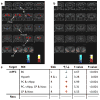Deep brain stimulation improves behavior and modulates neural circuits in a rodent model of schizophrenia
- PMID: 27302677
- PMCID: PMC5319857
- DOI: 10.1016/j.expneurol.2016.06.012
Deep brain stimulation improves behavior and modulates neural circuits in a rodent model of schizophrenia
Abstract
Schizophrenia is a debilitating psychiatric disorder with a significant number of patients not adequately responding to treatment. Deep brain stimulation (DBS) is a surgical technique currently investigated for medically-refractory psychiatric disorders. Here, we use the poly I:C rat model of schizophrenia to study the effects of medial prefrontal cortex (mPFC) and nucleus accumbens (Nacc) DBS on two behavioral schizophrenia-like deficits, i.e. sensorimotor gating, as reflected by disrupted prepulse inhibition (PPI), and attentional selectivity, as reflected by disrupted latent inhibition (LI). In addition, the neurocircuitry influenced by DBS was studied using FDG PET. We found that mPFC- and Nacc-DBS alleviated PPI and LI abnormalities in poly I:C offspring, whereas Nacc- but not mPFC-DBS disrupted PPI and LI in saline offspring. In saline offspring, mPFC-DBS increased metabolism in the parietal cortex, striatum, ventral hippocampus and Nacc, while reducing it in the brainstem, cerebellum, hypothalamus and periaqueductal gray. Nacc-DBS, on the other hand, increased activity in the ventral hippocampus and olfactory bulb and reduced it in the septal area, brainstem, periaqueductal gray and hypothalamus. In poly I:C offspring changes in metabolism following mPFC-DBS were similar to those recorded in saline offspring, except for a reduced activity in the brainstem and hypothalamus. In contrast, Nacc-DBS did not induce any statistical changes in brain metabolism in poly I:C offspring. Our study shows that mPFC- or Nacc-DBS delivered to the adult progeny of poly I:C treated dams improves deficits in PPI and LI. Despite common behavioral responses, stimulation in the two targets induced different metabolic effects.
Keywords: Deep brain stimulation; FDG-PET; Latent inhibition; Maternal immune activation rat model; Prepulse inhibition; Schizophrenia.
Copyright © 2016. Published by Elsevier Inc.
Figures





References
-
- Angelov SD, Dietrich C, Krauss JK, Schwabe K. Effect of deep brain stimulation in rats selectively bred for reduced prepulse inhibition. Brain Stimul. 2014;7:595–602. - PubMed
-
- Barak S, Weiner I. Putative cognitive enhancers in preclinical models related to schizophrenia: the search for an elusive target. Pharmacol Biochem Behav. 2011;99:164–189. - PubMed
-
- Ewing SG, Winter C. The ventral portion of the CA1 region of the hippocampus and the prefrontal cortex as candidate regions for neuromodulation in schizophrenia. Med Hypotheses. 2013;80:827–832. - PubMed
-
- Falkai P, Wobrock T, Lieberman J, Glenthoj B, Gattaz WF, Moller HJ. World federation of societies of biological psychiatry (WFSBP) guidelines for biological treatment of schizophrenia, part 1: acute treatment of schizophrenia. World J Biol Psychiatry. 2005;6:132–191. - PubMed
Publication types
MeSH terms
Substances
Grants and funding
LinkOut - more resources
Full Text Sources
Other Literature Sources
Medical

